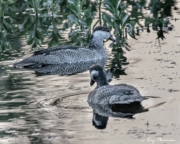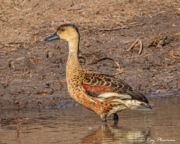Waterfowl
The waterfowl photo album comprises three galleries that display bird portraits that belong to the Duck, Geese, and Swan (Anatidae) and the Magpie Goose (Anseranatidae) families. See Taxonomy note at the end of this page.
The first gallery features portraits of dabbling ducks; the second displays diving ducks, perching ducks and shelducks. The final gallery features geese, swans, whistling-ducks, and a Magpie Goose.
Subsequent galleries display behavioural aspects of these bird families.
Dabbling Ducks
Dabbling Ducks Notes
The ‘Red List 2019’ of threatened species lists all the featured species as ‘Least Concern’. Dabbling ducks belong to tribe Anatini in subfamily Anatinae.
The Mallard is probably the most familiar and wide-ranging duck in the world with distribution in most of the Northern hemisphere and introduced in some Southern hemisphere locations. I’ve photographed locally (Hants/Berks border) and in several wetlands and in New Zealand where they hybridise with the Pacific Black Duck (Grey Duck).
Images of two Australian endemics: The Chestnut Teal and Maned Duck; together with a White-cheeked Pintail, a Galapagos sub-species endemic, feature in the gallery.
Most Dabbling Ducks (Anatini) exhibit sexual plumage dimorphism and breeding plumage variation.
Diving Ducks, Perching Ducks and Shelducks
Diving Ducks, Perching Ducks and Shelducks Notes
Apart from the Common Pochard, which is ‘Red List 2019’ as ‘Vulnerable’, all other featured species are ‘Least Concern’. Displayed in the gallery are images of ducks belonging to tribes Aythyini (Diving Ducks), Cairinini (Perching Ducks) and Tadornini (Shelducks), placed in subfamily Anatidae.
Images of two New Zealand endemic species feature in the gallery: New Zealand Scaup and Paradise Shelduck.
As with dabbling ducks, many of the Anatidae species exhibit gender plumage dimorphism and breeding plumage variation.
Geese, Swans, Whistling-Ducks and Magpie Goose


Geese, Swans, Whistling-Ducks and Magpie Goose Notes
All the displayed species in the gallery are ‘Red List 2019’ assessed as ‘Least Concern’.
Featured images are from tribe Anserini (Geese and Swans) together with photos from subfamilies Dendrocygninae (Whistling-Ducks) and Anseranatidae (Magpie Goose).
Two Canada Goose images feature; the nominate species photographed in England and probably ssp maxima in New Zealand, both introduced with well-established populations.
Cape Barren geese are Australian endemics where I photographed them and introduced species in New Zealand.
I photographed the Egyptian Goose, an introduced species, and the resident Greylag Goose in England.
The Black Swan is an Australian species with a well-established introduced population in New Zealand. I’ve photographed them in both countries and also in introduced ornamental wildfowl collections around the world.
Mute Swans have a wide distribution in Europe and Asia with feral populations in many areas including North America, Australia, and New Zealand. I photographed the images of a juvenile, immature and adult locally at Moor Green Lakes in Berkshire. Mute Swans are usually white at maturity, but the head and neck feathers are often stained orange-brown by iron and tannins in the water.
The plumed Whistling Duck is an Australian endemic and the Wandering Whistling Duck an Australian subspecies endemic.
Waterfowl Taxonomy
The Waterbirds Photo Album webpage describes the higher-level taxonomy for the waterfowl families placed in order Anseriformes. The album comprises two of the three families from this order:
(a) Anseranatidae (Magpie Goose) with just one family species,
(b) Anatidae (Ducks, Geese, Swans) with over 160 species, comprised of several subfamilies. Included in the photo album are Anatinae (Ducks), Anserinae (Geese and Swans) and Dendrocygninae (Whistling-ducks). The first two subfamilies split into Tribes:
(i) Anatinae (Ducks) divided into four tribes: Dabbling Ducks (Anatini); Diving Ducks (Aythyini); Perching Ducks (Cairinini) and Shelducks (Tadornini).
(ii) Anserinae (Geese and Swans) contain four tribes, but only Geese and Swans (Anserini) feature in the gallery.


![Common [Eurasian] Teal (Anas crecca) male at Moor Green Lakes in Berkshire Common [Eurasian] Teal (Anas crecca) male at Moor Green Lakes in Berkshire](https://rayplowman.co.uk/wp-content/uploads/cache/2019/09/Common-Teal-Male-_GB_0856dg/3473358329.jpg)



































